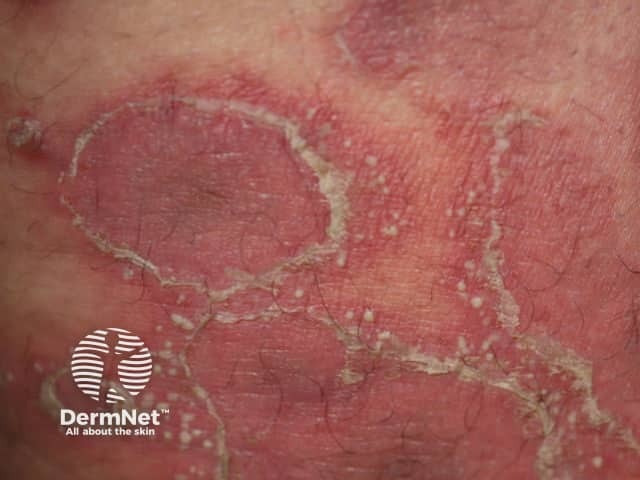Pustular psoriasis of Pregnancy
Introduction
Pustular psoriasis of pregnancy (PPP), formerly known as impetigo herpetiformis, is a rare, severe variant of generalized pustular psoriasis uniquely associated with pregnancy. It most commonly arises during the third trimester but can occur earlier or postpartum and has a tendency to recur in subsequent pregnancies, often at an earlier stage. Hormonal factors, such as oral contraceptive use and menstrual cycles, are believed to contribute to its onset. Additionally, a personal or family history of psoriasis highlights the role of genetic and immunological predisposition.
Clinical Manifestation
PPP typically presents with symmetrical, annular, or polycyclic erythematous plaques surrounded by sterile pustules at their margins. These lesions begin in intertriginous areas and gradually spread to the trunk and extremities, sparing the face, palms, and soles. Over time, pustules coalesce to form large plaques with scaling and residual red-brown pigmentation. Oral mucosal involvement is rare but may cause erosive lesions.
Systemic symptoms are common and include fever, malaise, nausea, vomiting, diarrhea, and arthralgia. Severe cases may present with life-threatening complications such as tachycardia, delirium, tetany, or seizures. While pruritus is uncommon, nail changes like onycholysis and pitting may occur.
Diagnosis
The diagnosis of PPP is primarily clinical, based on the characteristic pustular rash and associated systemic symptoms. Microbiological swabs of pustules, often negative, are useful in excluding infectious causes. Laboratory tests typically show leukocytosis, elevated inflammatory markers, and metabolic abnormalities such as hypocalcemia and hypoalbuminemia. Histopathological examination of a skin biopsy remains the definitive diagnostic tool, revealing hallmark features such as spongiform pustules of Kogoj, psoriasiform hyperplasia, and neutrophilic infiltration in the epidermis. Accurate diagnosis is vital to ensure timely management and reduce maternal and fetal complications.
Treatment
The goal of management in Pustular Psoriasis of Pregnancy is to alleviate mother symptoms and protect fetal health.
General measures
- Ensure adequate hydration and maintain electrolyte balance
- Provide pain relief
- Emollients
- Monitor fetal well-being closely via ultrasound and non-stress tests
Medications
- High dose systemic steroids
- Suitable alternatives like cyclosporine and biologics agents like infliximab may be used in refractory cases
- Narrowband UVB is an option for mild disease
- Retinoids or methotrexate can be used postpartum in non-breastfeeding patients
Prognosis
Pustular psoriasis of pregnancy usually settles quickly after delivery of the baby, although some changes of psoriasis may persist long-term.
Pustular psoriasis of pregnancy can recur with subsequent pregnancies, and may present earlier in the next pregnancy and in a more severe form. Pustular psoriasis of pregnancy carries a poor prognosis for mother and/or fetus if untreated.
Written by:
Dr. Renad Alkaanan
Revised by:
Naif Alshehri, Medical Intern
Resources:
UpToDate
Dermnet

